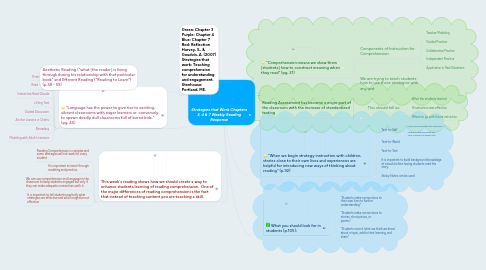Strategies that Work Chapters 3, 4 & 7 Weekly Reading Response
Nicole Keaneyにより


1. Green: Chapter 3 Purple: Chapter 4 Blue: Chapter 7 Red: Reflection Harvey, S., & Goudvis, A. (2007) Strategies that work: Teaching comprehension for understanding and engagement. Stenhouse: Portland, ME.
2. "Language has the power to give rise to exciting, vibrant classrooms with eager learners or, conversely, to spawn deadly dull classrooms full of bored kids." (pg. 45)
2.1. Think-Alouds
2.2. Read -Alouds
2.3. Interactive Read-Alouds
2.4. Lifting Text
2.5. Guided Discussion
2.6. Anchor Lessons or Charts
2.7. Rereading
2.8. Modeling with Adult Literature
3. Aesthetic Reading ("what [the reader] is living through during his relationship with that particular book" and Efferent Reading ("Reading to Learn") (p.58 - 59)
4. This week's reading shows how we should create a way to enhance students learning of reading comprehension. One of the major differences of reading comprehension is the fact that instead of teaching content you are teaching a skill.
4.1. Reading Comprehension is complex and some strategies will not work for every student
4.2. It is important to teach through modeling and practice.
4.3. We can use comprehension and Language in the classroom to keep students engaged but only if they can make adequate connections with it.
4.4. It is important to tell students explicitly what strategies are effective and which might be not effective
5. "Comprehension means we show them [students] how to construct meaning when they read" (pg. 31)
5.1. Components of Instruction for Comprehension:
5.1.1. Teacher Modeling
5.1.2. Guided Practice
5.1.3. Collaborative Practice
5.1.4. Independent Practice
5.1.5. Application in Real Situations
5.2. We are trying to teach students how to use these strategies with any text
6. Reading Assessment has become a major part of the classroom with the increase of standardized testing
6.1. This should tell us:
6.1.1. What the students learned
6.1.2. If instruction was effective
6.1.3. Where to go with future instriction
7. "When we begin strategy instruction with children, stories close to their own lives and experiences are helpful for introducing new ways of thinking about reading" (p.92)
7.1. Text-to-Self
7.1.1. Make connections with the characters
7.1.2. Help you understand what the story is doing on a deeper level
